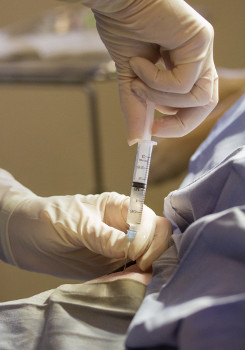 The usual protocol for the initial treatment of muscle and tendon injuries includes rest, ice, compression, and elevation of the injured area. This combination prevents further injury, reduces pain, inflammation, and swelling and thereby encourages healing. Not exactly an easy task when dealing with dogs and cats. Physical rehabilitation is usually applied when the acute stage of injury has subsided. It usually involves massage, stretching, and exercises, many times augmented with ultrasound and acupuncture therapy. Non-steroidal and steroidal anti-inflammatory drugs are also commonly used. Surgery is reserved for the more severe and intractable injuries. However, we now have a new tool available to us and we are excited to be able to offer PRP to our patients!
The usual protocol for the initial treatment of muscle and tendon injuries includes rest, ice, compression, and elevation of the injured area. This combination prevents further injury, reduces pain, inflammation, and swelling and thereby encourages healing. Not exactly an easy task when dealing with dogs and cats. Physical rehabilitation is usually applied when the acute stage of injury has subsided. It usually involves massage, stretching, and exercises, many times augmented with ultrasound and acupuncture therapy. Non-steroidal and steroidal anti-inflammatory drugs are also commonly used. Surgery is reserved for the more severe and intractable injuries. However, we now have a new tool available to us and we are excited to be able to offer PRP to our patients!
When tissue is injured, the inflammatory response is triggered. This is necessary even though the heat and swelling are unpleasant. Inflammation stops the spread of infection and clears away damaged tissue. However, healing of the tissues cannot take place until the inflammation process is switched off. Platelets play a role in the control of both of these processes. Most everyone thinks of blood platelets as being responsible for blood clotting after injury, which is true. What many people do not know is that blood platelets serve two other important functions. Blood platelets are responsible for bringing the white blood cells to the injured area to clean up the remains of dead and injured cells. Most importantly, blood platelets release growth factors that are directly responsible for tissue regeneration. By ultimately inhibiting inflammation, platelets form part of the mechanism that switches the process off, and stimulates healing by producing the various tissue growth factors mentioned above which stimulate new blood vessel growth. Because of this, Platelet Rich Plasma (PRP) treatment appears to be excellent for tendon, ligament, muscle, and joint injuries, which have been historically normally slow to heal.
PRP is derived from blood that is drawn from the patient and run through a special centrifuge, which separates the blood’s less dense components from its heavier ones. This process distills a portion of the blood to a platelet concentration level that is much richer than regular blood. At the same time, it helps to remove both red and white blood cells from the platelet rich part of the plasma.
Plasma containing this concentrated level of platelets provides an abundance of the previously mentioned growth factors, which are the proteins in the body that stimulate cells in the tendon, ligament, muscle, or joint to start the healing process. When PRP is injected into damaged tendons or ligaments, cells in the tissue—along with new cells circulating in the blood—are stimulated to bring even more new cells to the injured site. Therefore, the growth factors derived from platelets initiate connective tissue healing, bone regeneration and repair, promote development of new blood vessels, and generally stimulate the wound healing process by accelerating epithelial and epidermal regeneration. Because the patient’s own blood is used to make the specialized plasma there is no risk of the treatment being rejected, as it might be if the blood had been provided by a donor.
PRP has been directed towards Achilles tendon injuries, cruciate ligament injuries, complicated orthopedic fractures and delayed bone healing and degenerative joint disease of the shoulder, elbow, hip, knee, and ankle. The number of injections performed depends upon the severity and type of condition being treated. The use of certain anti-inflammatory drugs is not recommended during PRP therapy as they may diminish the success of the procedure by interfering with the initial inflammatory reaction induced by the platelets. The use of omega 3 and 6 essential fatty acid fish oil supplements and other natural anti-inflammatory agents do not seem to work the same way as the non-steroidal anti-inflammatory agents and are therefore not restricted in use throughout the platelet facilitated natural healing process. Depending upon the condition being treated, your pet may require nothing more than a local anesthetic for the administration of PRP, or may require a ‘twilight’ anesthetic. A real advantage to PRP therapy is that it may not only facilitate the healing process, it may in certain cases provide an alternative to surgery.
While platelet rich plasma therapy offers a promising solution to accelerate the healing of bone, muscle, tendon, ligament, and joint conditions naturally without subjecting the patient to invasive surgical procedures and significant risks, there is no one, standard protocol. Frequently, chronic injuries require more than one injection. In both acute and chronic injuries, injections may be combined with an exercise or physical therapy program, acupuncture and/or cold laser therapy to enhance the success of the treatment.
